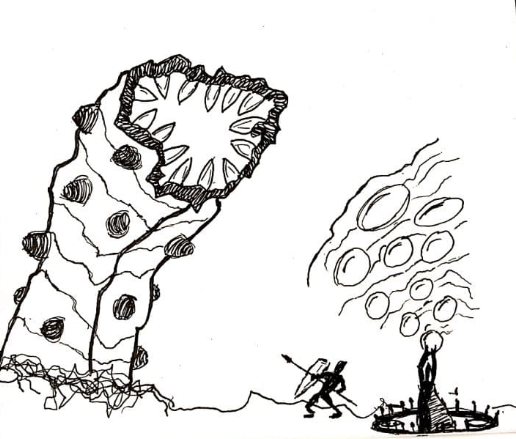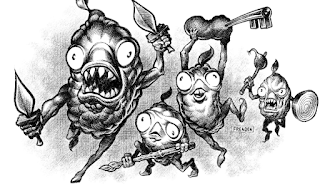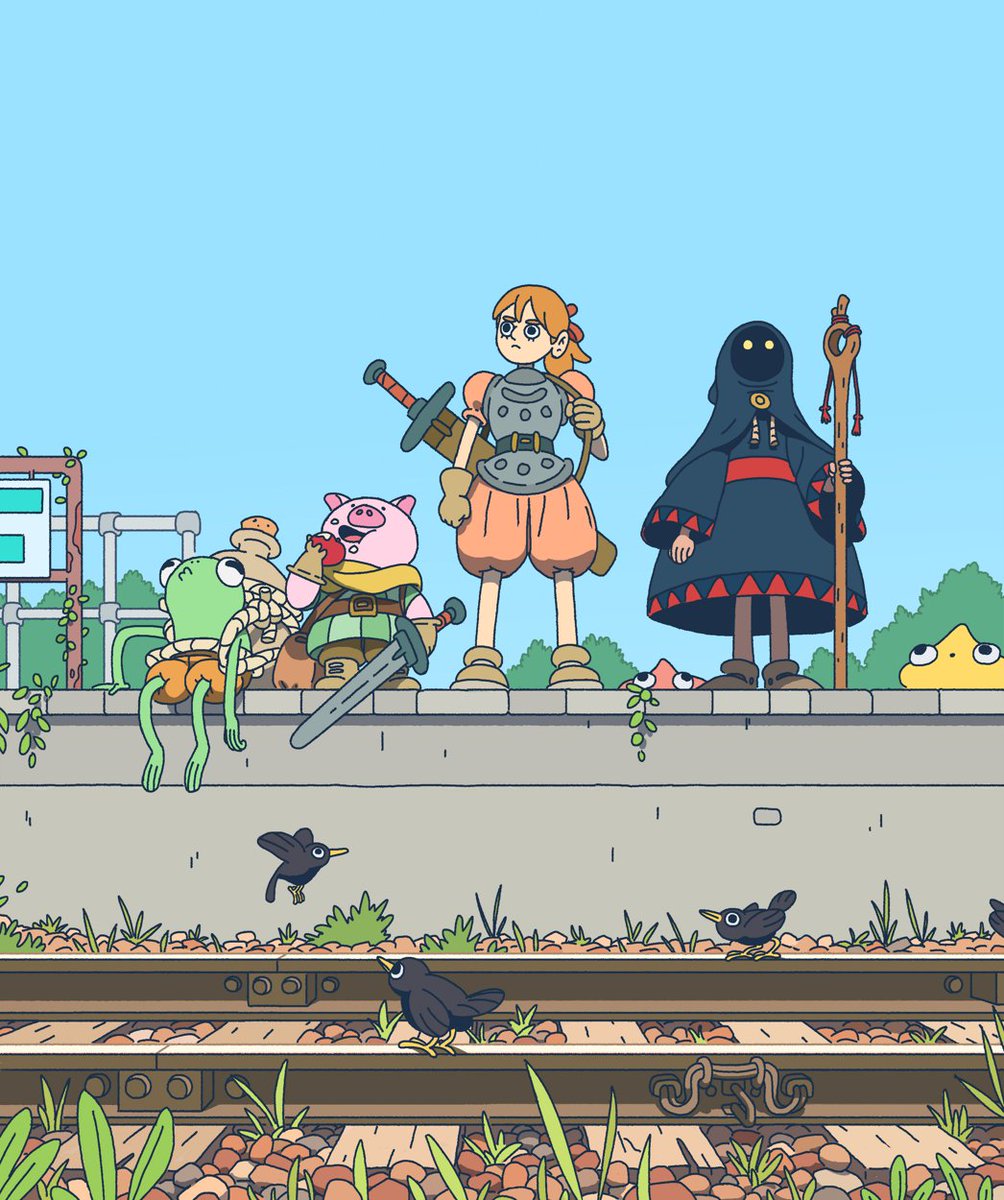See some disclaimers at the end of this post.
Overall feel
Gourmet street is a 20 page-long zine (including front- and back
cover, forewords, etc.), by
John Gregory and
Charles Ferguson-Avery. 17 pages of actual content, showcasing Gourmet Street, a pocket-dimension bizarre food location with adventuring potential. It taps into the underutilized potential of rations, food, beverages (and potions?) that every adventurer needs, and many OSR games track (often blandly and without flavor). As for other previous works by the authors, I own
Into the Wyrd and Wild, which I consider a helpful toolkit for running forest-wilderness adventures. And I read John's blog posts when they pop up in my feed (linked above).
Ideas within the text of Gourmet Street are bizarre, and numerous. The kind I couldn't or wouldn't come up with myself easily: factions, monsters, items, MANY MANY dish names.
A stewing pot with so many ideas, the layout and art seem just like an extra ingredient in this one, as convoluted as I imagine the food stalls of Gourmet Street to be. There are a variety of font types and sizes, where some are too small for my aged eyes (tables on pages 4, 5, 18, 19). For instance take the
Schnapshund on page 14. This monster gets a reduced font compared to the other monsters in that small section. It breaks flow and consistency. The bullet points of the
Classicists faction are indented, whereas the other factions' aren't. There are mocks of coffee stains and grease marks sprinkled throughout, resembling a used cookbook. Similar to what
Macchiato Monsters did; I like that touch.

Art throughout is consistent and abundant (all except the full-table pages get some), but perhaps too sketchy for my taste? It's definitely less finalized and feels more rushed than Avery's other work, including Into the Wyrd and Wyld or the
Sphinxes zine. There are some typos or odd language choices here and there, but nothing too off-putting, definitely not for a zine publication.
When I backed this, I was hoping for a bizarre setting like
Ynn or the Stygian Library, that can be dropped into any campaign or setting (since food and carousing are quintessential to the adventuring life). Random tables, optional rules, monsters, and all the goodness.
The first page of arguable content is a Using this Zine background section. References and influences are cited (movies, shows, comics like K6BD, etc). Bizarre people are meant to make these food stalls, the vendors. Claims to be rules system agnostic (citing some recommendations like Knave, B/X, DCC, Troika!, 5e, etc), and frankly in my limited experience that's harder to get right than choosing a system and even loosely sticking to it.
What's on the Menu? and other tables
Opening with the question What's on the Menu?, the first two-page spread provides one of the ingredients the OSR does best: random tables. Precisely two of them, with d100 and d20 entries.
The first table has 100 dishes (Today's Special), 100 Beverages, and 100 Condiments. Dish names are filled with D&D references, bringing in that this is no mundane serving. Beverages and condiments seem more mundane in nature, but there are a lot of them I haven't heard of. Great stuff! Exactly the crap I won't come up with on the fly, I can roll a few before the game, or just read each entry. Some rolled examples so you get the idea:
- Baku Snout Tartar, with Wasabi. To drink, there's Dancha Tea
- Demonic Bee Honey on Toast, with Umeboshi. To drink, there's Black Coffee
- Soft-Shelled Crabman Sandwich, with Pimento Cheese. To drink, there's Seagul Wine
The second table, a d20, has tille + vendor + stall + quality + frequent customer entries. Might seem quite dense to parse, but skimming ahead the rest of the zine, it contains a lot of the Gourmet Street setting, excluding the factions ahead. Other than flavor, there is nothing here in terms of gameable material, food effects, or rules.
An improvement idea for the layout: split the d100 tables in 50 entries per page, and move the d20 table into a new page spread, perhaps with an illustration? And add some extra content for Interactivity & Exploration in that new spread!.
Gourmet Street
A two-page spread introducing the feel of Gourmet Street, with a crude sketch of the food stalls. Perhaps too crude? Factions struggling for power within the setting, that's the main dish! Four factions are presented in the next two pages.
They are: The Newo Gastro Alchemists, The Classicists, The Vinegar Knights, and The Brewer's Bloc. Each comes with bullet points with their credo, peculiarities, and the head face running that group. In addition, each faction gets a Boon and a Bane (not to confuse with SotDL mechanics!). For when (if?) the PCs enlist the ranks of one of them, they can get a badge of customer loyalty. Of note is also a logo for each of the four factions (upper corners in the image below).
Next, a
bestiary with a total of 5 creatures. Things that can go wrong and give some action in and around Gourmet street. Some like the
Wolf Yeast and the
Schnapshund are part of
John's blog, although they received some very minor editing in the zine.
Gloop!s should be treated as treasure, since their main gimmick is to be fed for a period of time, to then develop a random effect from the d20 table (a Tasty Power!). The effects of that d20 table are great for minor magical trinkets too. Lastly, saving the effects of a poison in the Gloop! seems pretty pointless to me, but perhaps I'm missing something.
Froth Goblins are exactly what you'd expect: sugar junkies. HD 0 seems like a typo, and the Yeast Infection is only explained in the Wolf Yeast entry, and is a nasty condition. I really like monsters that on paper are not a threat to the HP, but instead have diseases, tackle equipment, etc.
The Prince of Cucumber Sandwiches is too cheeky for me to use in a game, but an enjoyable read.
Next we have a short d10 table of Cookbook Names. It feels like an opportunity was missed, by not having them expanded into spell books or tacking a minor power or effect to each one that can be used in an actual game. I suppose this is left to the reader to figure out.
The six Magic Items provided are memorable, and frankly some of the best content in the supplement. A pan fitted for a giant that you can wield, yeast capable of spanning Wolf Yeasts, a portable food stand (reminds me of Dragon Ball), and so on.
After consuming the bulk of the zine and what Gourmet Street is meant to be, I can't help to find myself mildly puzzled. Great content that amounts to a goofy setting's sprinkling, but we are missing the meat of it. And the 2 pages of factions lack enough weight to carry the whole setting. What is Gourmet Street? I still don't really know. This is a missed opportunity in presenting food & beverages effects, intoxication rules, or what have you that can be used during actual play. As it stands, most of it is left to the reader to figure out. Perhaps my thesis of this being an adventuring location was wrong. But even as a "hub" or area to convert that hard earned gold into XP, it lacks rumors, quest ideas, carousing tables, etc. I feel it would take very significant effort to bring this to the table in a satisfying way.
One-page adventure
To close, Escape from Gourmet Street is a one-page adventure presented in the last spread of the zine.
PCs are to help escape a couple of lovers, that have upset the Factions by an unapproved union, and here we are. We get a random table to generate the lovers, which has just enough description to portray them in a refreshing way; nice!
Chase mechanics are dead simple, but I imagine quite effective and amusing at the table. In my experience taking cards, boards, or other mini-games into your game is received well. Additional movement can be handed to the chased PCs, but is left to GM/Ref-fiat, something I'm not too fond of. The pursuers are also left for the Referee to find flesh out, from some of the factions provided.
Depending on the outcome, a random Event can happen (d20 table). The entries are short, one-sentence effects again open to interpretation. 1-11/12 are clearly bad to the PCs, the rest are either an asset or an obstacle. For the most part, entries are not particularly inspiring.
This feels like part of an adventure, more like a chase mechanic idea, that needs considerable fleshing out to be brought to the table.
This
concludes the review. The gonzo food setting of Gourmet Street has some interesting notes and bits (the factions and the magic items were my favorite). I can't help but feel that keeping it rules light/generic hurt the actual material, missing more effects for foods and drinks. It felt like the setting is neither an adventuring location nor a hub to rest and carouse, and the actual Gourmet Street core structure was missing.
Disclaimer
- In the interest of full disclosure I bought this with my own funds.
- I was a backer on their Kickstarter campaign and paid 10 US$ for the print+PDF version of the product in February 2020. Plus another additional 5 US$ for shipping.
- Nobody is paying for this review. All of the opinions you see are my own.
- Nobody is approving or reading this post before it goes up.
- I have no relationship with any of the authors of this product.


























